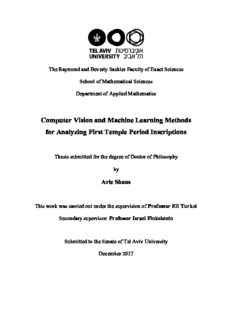
Computer Vision and Machine Learning Methods for Analyzing First Temple Period Inscriptions PDF
Preview Computer Vision and Machine Learning Methods for Analyzing First Temple Period Inscriptions
The Raymond and Beverly Sackler Faculty of Exact Sciences School of Mathematical Sciences Department of Applied Mathematics Computer Vision and Machine Learning Methods for Analyzing First Temple Period Inscriptions Thesis submitted for the degree of Doctor of Philosophy by Arie Shaus This work was carried out under the supervision of Professor Eli Turkel Secondary supervisor: Professor Israel Finkelstein Submitted to the Senate of Tel Aviv University December 2017 Dedicated to the blessed memory of my late nephew Ido Gofer and my late uncle Ilya Shaus. Acknowledgements I would like to express the sincerest gratitude to my supervisor, Prof. Eli Turkel, for his thoroughly knowledgeable advices, suggestions, corrections and, no less importantly, his kind demeanor and infinite patience, contributing to successful culmination of this thesis. I would also like to thank my secondary supervisor, Prof. Israel Finkelstein, for his ongoing support, thought-provoking riddles, and an inspiration to aim at unearthing the answers to the “big questions”. Although not a formal supervisor, Prof. Eli Piasetzky was instrumental in inaugurating and backing my research, while pushing many of the investigations beyond their finishing line, and I’m grateful to him. I would like to thank the Lautman family and the Adi Lautman Interdisciplinary Program for Outstanding Students for the wealth and scope of knowledge acquired during my first academic steps, including the generous funding and scholarships. I’m also thoroughly grateful to the Azrieli family and to the Azrieli Foundation for the award of an Azrieli Fellowship, to the Foundation’s ever-positive program manager, Ms. Rochelle Avitan, the program coordinator, Ms. Yula Panai, as well as the Foundation’s coordinator at TAU, Ms. Shoshi Noy, for their sympathetic help. This study was also supported by a generous donation of Mr. Jacques Chahine, made through the French Friends of Tel Aviv University. The considerable help of Amalia Biron- Cegla Scholarship, Early Israel Grant (New Horizons project), and Electronic Imaging Student Grant is similarly acknowledged. In addition, the research received funding from the Israel Science Foundation – F.I.R.S.T. (Bikura) Individual Grant no. 644/08, the Israel Science Foundation Grant no. 1457/13, and the European Research Council under the European Community's Seventh Framework Programme (FP7/2007- 2013)/ERC grant agreement no. 229418. 5 I would also like to express gratitude to my dear longue durée friends, confidants, colleagues, coauthors, reviewers, critics and tee-drinking associates, Shira Faigenbaum-Golovin and Barak Sober. The cooperation with Anat Mendel- Geberovich, in particular on character recognition, documentation and smoothing, was ever so engaging. I’m also grateful to Yariv Aizenbud and Eythan Levy for stimulating discussions and encouragement. I would also like to acknowledge the valuable assistance, advice and cooperation from Dr. Leah Bar, Ms. Yael Barschak, Dr. Shirly Ben-Dor Evian, Mr. Michael Cordonsky, Ms. Judith Dekel, Ms. Sivan Einhorn, Ms. Noa Evron, Ms. Liora Freud, Mr. Assaf Kleiman, Ms. Tamar Lavee, Prof. David Levin, Prof. Murray Moinester, Ms. Ma’ayan Mor, Prof. Nadav Na’aman, Ms. Myrna Pollak, Prof. Christopher A. Rollston, Prof. Benjamin Sass, Mr. Pavel Shargo, Prof. David M. Steinberg, and Prof. Bruce E. Zuckerman. Your help is greatly appreciated. This research is also in great debt to the late Prof. Itzhaq Beit-Arieh. The remarks of the anonymous reviewers were very beneficial for the improvement of the text. Finally, I would like to thank my family: my parents, for cultivating my curiosity since early age; my dear sister Maria, her husband Itay, and their cute kids Ido, Noa and Omri for little moments of happiness; my fiancée Anna for her unconditional love and support - you undoubtedly deserve another thesis for your perseverance in developing countless ways to encourage my work on the thesis (!ةبوبحم اركش); and our beloved dog Hatti, who helped me finalize my ideas during our mutual walks. Ostraca images: courtesy of the Institute of Archaeology, Tel Aviv University (photographer: Michael Cordonsky) and the Israel Antiques Authority. Facsimiles: 6 courtesy of Ms. Judith Dekel; of the Israel Exploration Society (Aharoni 1981); and of Prof. C. A. Rollston (Rollston 2006). Full spectrum color images of the Dead Sea Scrolls courtesy of the Israel Antiques Authority (photographer: Shai Halevi; Dead Sea Scrolls 2016). Paleographic tables are courtesy of the Israel Exploration Society (Aharoni 1981). 7 8 Abstract The thesis concentrates on computational methods pertaining to ancient ostraca - ink on clay inscriptions, written in Hebrew. These texts originate from the biblical kingdoms of Israel and Judah, and dated to the late First Temple period (8th – early 6th centuries BCE). The ostraca are almost the sole remaining epigraphic evidence from the First Temple period and are therefore important for archaeological, historical, linguistic, and religious studies of this era. This “noisy” material offers a fertile ground for the development of various “robust” image analysis, image processing, computer vision and machine learning methods, dealing with the challenging domain of ancient documents’ analysis. The common procedures of modern epigraphers involve manual and labor-intensive steps, facing the risk of unintentionally mixing documentation with interpretation. Therefore, the main goal of this study is establishing a computerized paleographic framework for handling First Temple period epigraphic material. The major research questions, addressed in this thesis are: quality evaluation of manual facsimiles; quality evaluation of ostraca images; automatic binarization of the documents and its subsequent refinement; quality evaluation of binarizations on global and local levels; identification of different writers between inscriptions (two distinct methods are proposed); image segmentation (with improvements over the classical Chan-Vese algorithm); and letters’ shape prior estimation. The developed methods were tested on real-world archaeological and modern data and their results are found to be favorable. 9 10
Description: